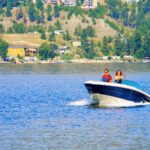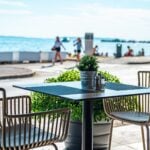When people think of Canada, they often picture vast landscapes, towering mountains and sprawling forests. And for good reason—Canada is the second-largest country in the world, covering almost 10 million square kilometers. But tucked away on the eastern edge of the country is a tiny province with a big personality: Prince Edward Island (PEI). With its red-soil fields, cozy coastal towns and warm maritime charm, PEI might be the smallest of Canada’s 10 provinces but it’s an experience as big as any of the country’s largest regions.
Welcome to Canada: A Country of Contrast and Diversity
Before we get to PEI, let’s take a look at the vast and varied landscape that is Canada. This is a country of extremes—from icy tundra in the north to lush forests and sparkling lakes in the south. Most of the population is concentrated in a few southern provinces, particularly Ontario and Quebec which together hold almost two-thirds of the population.
Canada is divided into 10 provinces and 3 territories. Provinces like PEI have jurisdiction over major public services like education and healthcare, while territories rely more on federal government. Despite the difference in political structure, every region of Canada has its own identity.
A Snapshot of Prince Edward Island: Small but Mighty
Located in the Gulf of St. Lawrence and connected to mainland Canada by the Confederation Bridge, Prince Edward Island is just 5,660 km²—a tiny fraction of the size of its provincial siblings. But don’t let its size fool you. This island is full of character, history and natural beauty.
The island’s capital Charlottetown is often called the “Birthplace of Confederation” because it hosted the 1864 conference that led to Canada’s creation. Today, Charlottetown is a mix of historic charm and modern comforts with a lively arts scene, cozy cafes and waterfront views.PEI’s red soil, due to its high iron oxide content, supports a thriving agricultural industry. Potatoes are big business here—PEI produces about a quarter of all the potatoes grown in Canada. The island also relies on fishing, aquaculture and an increasingly popular tourism sector.
Outdoor Adventures and Cultural Highlights
If you love the outdoors, PEI is a paradise. Its gentle hills, scenic trails and rolling countryside are perfect for cycling, hiking and beach-hopping. The Confederation Trail, built on old railway lines, runs across the island and is great for biking or walking.
PEI’s beaches are another major attraction. The island has over 800 km of coastline, with sandy shores, warm waters and dramatic cliffs. The Prince Edward Island National Park is a must-see, with dunes, wetlands and rare bird species.
Culture lovers will find inspiration in PEI’s literary history. The island was home to Lucy Maud Montgomery, author of Anne of Green Gables. Fans can visit Green Gables Heritage Place in Cavendish to step into the world of Anne Shirley.
PEI vs Its Maritime Neighbours
PEI is one of the three Maritime provinces, along with Nova Scotia and New Brunswick. While each province shares a common Atlantic heritage, they all have their own unique:
- Nova Scotia is bigger (21,345 square miles) and has a rugged coastline and famous sites like Cape Breton Highlands National Park.
- New Brunswick is just under 30,000 square miles and is Canada’s only officially bilingual province (English and French). It’s home to the Bay of Fundy, with the highest tides in the world.
- Newfoundland and Labrador, though not a Maritime province (it’s part of Atlantic Canada), is even further east and has a mix of Indigenous, Irish and British influences.
Compared to these provinces, PEI feels smaller and more accessible but just as rich in culture and scenery.
Canada’s Largest Provinces
To really get a sense of how small PEI is, consider this:
Quebec, Canada’s largest province, is 1,542,056 km²—over 270 times bigger than PEI. Quebec is French-speaking, has vibrant cities like Montreal and Quebec City and vast northern wilderness.
Ontario, the second-largest province (1,076,395 km²) is the economic engine of Canada. It’s home to Toronto, the biggest city in Canada and the nation’s capital, Ottawa.
British Columbia, Canada’s third-largest province is famous for the Rocky Mountains, Pacific coastline and the city of Vancouver.
These provinces are a whole different world from the rural island life found on PEI.
National Parks, Conservation and Natural Heritage
Canada is committed to preserving its natural beauty. From the mountains of Banff and Jasper in Alberta to the tides of Fundy National Park in New Brunswick, the national parks system shows off the country’s diversity.
PEI National Park may not be as big as its western cousins but it has its own unique features—coastal dunes, barrier islands and a surprising amount of biodiversity for its size. Managed by Parks Canada, these protected areas ensure future generations can enjoy the same environments.
Provincial Powers and How They Shape Life in Canada
While the federal government handles defence and foreign policy, each province is responsible for services like healthcare, education and resource management. This means life in PEI is very different from life in Alberta or British Columbia—not just culturally but practically.
For example, PEI’s focus on local agriculture, community-based healthcare and rural education shapes the daily lives of its residents. Provinces also collect taxes and make laws tailored to their population’s needs, adding to the diversity of life across Canada.
The Northwest Territories: A World Away from PEI
While PEI is Canada’s smallest province, the Northwest Territories (NWT) is one of its largest and most remote regions. Covering a huge chunk of northern Canada.The NWT is a whole different Canada—glaciers, tundra and a deep connection to the land and traditional ways of life. It’s a reminder of the many contrasts within one country—from tiny green islands to vast Arctic landscapes.
One More Thing…
Let me introduce you to something special. Our Canada Hustle app is the perfect answer when you are looking to make your stay fun and easy. Finding the best adventures in the Canadian provinces and cities is just a few clicks away.
Available for both Android and iOS users, this one’s a perfect travel buddy. Your kind of travel—bold, curious, or tranquil—is what Canada Hustle is designed for.
Conclusion: Why PEI Should Be on Your Travel List
Although small in size Prince Edward Island is big in experience. It’s the kind of place where time slows down, where nature and history meet and where the sea is never far away. Whether you’re cycling coastal trails, exploring charming villages or sinking your teeth into the island’s famous seafood, PEI will welcome you with open arms.
So if you’re looking for a Canadian adventure but want something a little off the beaten path don’t overlook the little island that could. Prince Edward Island may be Canada’s smallest province but it makes a big impact.







